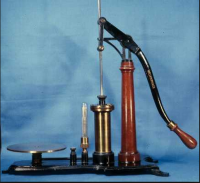








A vacuum pump is a device that removes gas molecules from a sealed volume in order to leave behind a partial vacuum. The first vacuum pump was invented in 1650 by Otto von Guericke, and was preceded by the suction pump, which dates to antiquity.
The predecessor to the vacuum pump was the suction pump, which was known to the Romans. Dual-action suction pumps were found in the city of Pompeii.Arabic engineer Al-Jazari also described suction pumps in the 13th century. He said that his model was a larger version of the siphons the Bizantines used to discharge the Greek fire.The suction pump later reappeared in Europe from the 15th century.
By the 17th century, water pump designs had improved to the point that they produced measurable vacuums, but this was not immediately understood. What was known was that suction pumps could not pull water beyond a certain height: 18 Florentine yards according to a measurement taken around 1635. (The conversion to metres is uncertain, but it would be about 9 or 10 metres.) This limit was a concern to irrigation projects, mine drainage, and decorative water fountains planned by the Duke of Tuscany, so the Duke commissioned Galileo to investigate the problem. Galileo advertised the puzzle to other scientists, including Gaspar Berti who replicated it by building the first water barometer in Rome in 1639.Berti's barometer produced a vacuum above the water column, but he could not explain it. The breakthrough was made by Evangelista Torricelli in 1643. Building upon Galileo's notes, he built the first mercury barometer and wrote a convincing argument that the space at the top was a vacuum. The height of the column was then limited to the maximum weight that atmospheric pressure could support; this is the limiting height of a suction pump,and the same as the maximum height of a siphon, which operates by the same principle.Some people believe that although Torricelli's experiment was crucial, it was Blaise Pascal's experiments that proved the top space really contained vacuum.
In 1654, Otto von Guericke invented the first vacuum pump and conducted his famous Magdeburg hemispheres experiment, showing that teams of horses could not separate two hemispheres from which the air had been evacuated. Robert Boyle improved Guericke's design and conducted experiments on the properties of vacuum. Robert Hooke also helped Boyle produce an air pump which helped to produce the vacuum. The study of vacuum then lapsed[dubious – discuss] until 1855, when Heinrich Geissler invented the mercury displacement pump and achieved a record vacuum of about 10 Pa (0.1 Torr). A number of electrical properties become observable at this vacuum level, and this renewed interest in vacuum. This,in turn, led to the development of the vacuum tube.
In the 19th century, Nikola Tesla designed an apparatus that contains a Sprengel Pump to create a high degree of exhaustion.